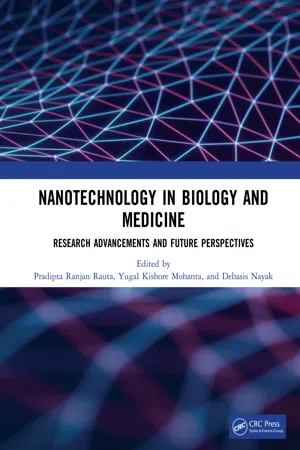1.1 Introduction
Nanobiotechnology is an amalgamation of material, chemical, and biological science with a common goal of manufacturing nanoparticles (NPs) that possess unique optical, magnetic, and biological properties. Basically, nanoparticles exhibit totally different characteristic properties from their bulk material owing to quantum confinement, which increases their surface-to-volume ratio, and their spectacular optical properties are due to the surface plasmon resonance (SPR) phenomenon (Fu & Yao, 2001). According to pharmaceutical science, nanoparticles are defined as submicronic solid therapeutics-carrying particles that are below 100 nm and/or can be biodegradable in nature; hence, in pharmaceutical terms they are referred as nanocapsules or nanospheres (Soppimath, Aminabhavi, Kulkarni, & Rudzinski, 2001). Further, based on their dimensions, nanomaterials can be categorized as follows. Zero-dimensional nanomaterials, such as nanoparticles, can be amorphous or crystalline and have applications in textiles and health care products. One-dimensional nanomaterials, such as thin film, have applications in various repository systems, biochemical sensors, laser systems, and magnetic and optical devices. Two-dimensional nanomaterials, such as carbon nanotubes (single and multi-walled), have applications in electrical and conductive devices. And three-dimensional nanomaterials, such as fullerenes, dendrimers, and quantum dots, have applications in electronics, diagnostics, and targeted drug delivery (Castagnola et al., 2017; Glezer, 2011).
Based on their composition, nanomaterials are a classified into metallic, ceramic, and polymeric nanoparticles. Metallic nanoparticles are basically composed from their metallic precursor materials, showing vibrant optical, electrical, magnetic, and biological properties owing to their large surface‐area‐to‐volume ratio, plasmon excitation, quantum confinement, and large surface energies (Buzea & Pacheco, 2017; Mody, Siwale, Singh, & Mody, 2010). Ceramic nanoparticles are mostly oxides, phosphates, nitrides, and carbides of various metallic and non-metallic elements. As ceramic nanoparticles are typically insulative to harsh chemical environments, electricity, and heat, they are mostly preferred in major orthopedic, dental, and other medical applications (Ajayan, Schadler, & Braun, 2006; Sternitzke, 1997).
Polymeric nanoparticles have the benefit of permitting the entrapment of bioactive molecules and defending them against hydrolytic and enzymatic degradation. Polymeric nanoparticles, the most versatile nanoparticles among the metallic and ceramic nanoparticles, are basically prepared from natural or synthetic polymers, which allows them to be utilized as drug carrier molecules for various drug delivery approaches (oral, parenteral, transdermal, and nasal). The polymeric nanoparticles provide a wide range of advantages such as the availability of a wide array of polymers which can be chosen according to their application, biodegradability, hemocompatibility, and targeted delivery to specified tissues (Farokhzad & Langer, 2009; Liu, Jiao, Wang, Zhou, & Zhang, 2008; Owens III & Peppas, 2006; R. Singh & Lillard Jr, 2009).
Polymers provide a complete diverse platform for drug delivery applications due to the presence of various natural polymers such as chitosan, gelatin, sodium alginate, albumin, and synthetic polymers such as polylactic acid (PLA), polyglycolic acid (PGA), poly(lactide co-glycolic acid) (PLGA), polyanhydrides, polyorthoesters, polycyanoacrylates, polycaprolactone, polyglutamic acid, poly (malic acid), poly(N-vinyl pyrrolidone), poly(methyl methacrylate), poly(vinyl alcohol) (PVA), poly(acrylic acid), polyacrylamide, poly(ethylene glycol) (PEG), and poly(methacrylic acid), which are biocompatible and biodegradable (Wang et al., 2007). Further, based on their preparatory routes, polymeric nanoparticles can be manufactured with various combinations that provide additional functional groups to the synthesized polymeric nanoparticle, which enables higher cell recognition and encapsulation efficiency for the targeted delivery of the encapsulated drug (Elsabahy & Wooley, 2012; Guterres, Alves, & Pohlmann, 2007). The modulation of polymers with nanotechnology offers multifaceted opportunities for designing polymeric nanoparticles with preferred shape, size, biocompatibility, and controlled drug release profile, which are exceptionally significant for biomedical applications. Supplementary to this, they can also be explored for their applicability in the biomedical field as nano-carriers for targeted delivery and as novel therapeutics with combinations of diverse natural and synthetic drug molecules (Shenhar, Norsten, & Rotello, 2005).
Pharmaceutically, polymeric nanoparticles are the most preferred nanoparticles owing to their considerably versatile physiochemistry, hemocompatibi...
